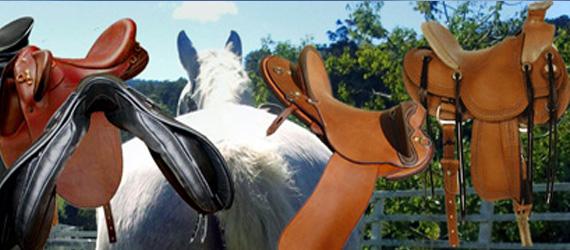It’s a familiar feeling. You’re online looking at the equine ads. Running through the listings, you see a saddle that makes your eyes widen with desire. What’s more, it’s at a price you can reasonably afford.
You can see it on your horse. You can feel yourself riding in it. The fantasy fires up and before you know it, you’ve logged on to authorize payment.
But sometimes the dream doesn’t work out. The package arrives and find you’ve just blown your one-time budget on the saddle of your nightmares.
It’s not what the seller said it was. It’s longer, it’s shorter. It’s lighter, it’s darker. It’s wider. Or narrower. It’s older (never newer). It’s damaged, it’s broken, it’s dodgier. Then you put it on your horse and your horse hates it. No two ways about it – the saddle’s a dud.
What’s worse, it’s now your dud.
The problem is that you got excited about that saddle. And nobody thinks straight when they’re excited. You just make excited, thought-free decisions.
Some people, the ones who find the great deals, do something else. They don’t get excited, not when they’re thinking of buying. Instead, they put some thought into the purchase they’re planning to make. And that’s just it – they plan.
It’s not hard to do. And it’s just as exciting. The difference is that you save your excitement for when the saddle arrives – and you find it’s everything you hoped for.
The 10 Steps to Saddle Heaven
You can improve your chances of finding a great saddle at the right price by following these before, during and after-purchase stages.
Step 1. Make your choice ahead of time
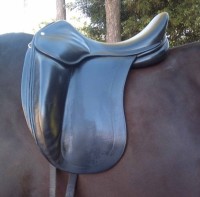
Most people find this step one part easy, two parts hard. You need all three – miss one out and you’ll run into problems.
The easy part is knowing which style of saddle will suit your purpose. What kind of riding do you want to do? And, if competitive, to what level? You probably know the answer to this already.
The slightly harder part is being sure that a saddle fits you. That’s your seat size and leg length. There’s also your pelvic anatomy – not everyone has the same design. You need to be able to ride in your regular position without hurting.
By far the hardest part is knowing whether a saddle will fit your horse.
You can’t guess – you need to do some road-testing. Here’s how.
Borrow some saddles from your friends and ride in them. See how they feel.
Browse the stores and see what’s out there.
Get a reputable saddle fitter to check saddles on your horse.
Learn how to check saddles yourself.
Once you identify a saddle that ticks all the boxes, note the brand, model, seat size and width fitting. Gullet sizes aren’t standard across different makes, so you need to check for each one. Take photos. Find out where the important measurements should be made and take photos of a tape measure across these points. This will be useful later.
Step 2. Avoid these 3 types of saddle
Let’s look at eBay. Have you seen the saddles on there with no brand name at all? Or a strange brand name you never see anywhere else? These often look like the big brands, but they’re just dodgy copies, usually from India.
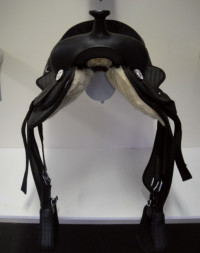
Get this: they’re poor quality, low durability, damaging to the horse and frequently unsafe for you. Even if they’re treeless. If a private seller is advertising one, they’ve realized their mistake too late. Don’t you be the person to repeat it.
Now for saddles that have a brand you’ve heard of, but that are cheap even when new. We all know them: they occupy the sink end of the market. Well, you know what? They don’t get better with age. Think on it: poor quality leather doesn’t last, a brittle tree cracks, weak fittings break, cheap flocking clumps, synthetic fleece wears away. And they have dimensions that don’t relate to many living horses.
Avoid them. Save more money and buy a better used saddle instead.
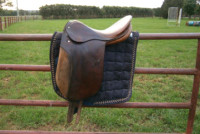
This last one may surprise you. It’s rarely a good idea to buy old leather saddles made by famous, well-established saddle companies. Not even the great classical makers from Europe. The fact is that saddle design has evolved in recent years, along with understanding of equine biomechanics. Saddles that are 15 to 30-years-old have features that are very likely to cause your horse physical problems.
‘Vintage’ styling may be attractive in furniture, clothes and cars, but not when it comes to saddles. Not unless they’re on display in a bar.
Step 3. Get your head around the market
Now you’ve settled on the style, make and model you want, it’s almost time to go hunting. But not quite.
First, you need to study these saddles ‘in the wild’. You need to watch enough online sales to be sure you’re buying at the right price. It’s best to stick to your own country, unless you’re ready for shipping costs, customs regulations and import duties. (If you are, research them first and factor in the costs.)
- Take your time. Do your research and identify the best sales sites:
- Google your target saddle’s name and the words ‘used saddle sale’.
- Check out horse forums and online stores.
- Set up saved searches on eBay.
- Search through the classifieds (such as Craigslist, Gumtree, etc).
- ‘Like’ Facebook horse-items-for-sale groups.
- Join equine special interest boards for your sport or interest.
- Don’t ignore local saddlers’ websites just because you can also walk into them.
- Ask around to learn what other people have paid for the saddles you like.
Now sit down and watch the selling and buying activity. Spot the item end times that yield lowest prices on eBay. Watch how quickly they sell. Note down the selling price and the age and condition of the saddle. Do you spot a trend? Watch enough and you’ll start to get a feel of how much they go for and what’s a good price – and what’s not.
You can now be strategic. Check different sites daily, every two days or weekly. Make it a habit and as soon as a saddle comes up for sale, you know about it. You’ll also know which of the crop are worth going after.
Step 4. Scrutinize the photos for the facts
You can tell a lot from photos. Given the fantastic images possible even with cell phones, the photos should be very good indeed. If you see a single blurred image, you’ve got a bone-idle seller. Don’t bother with them – they clearly can’t be bothered anyway.
Don’t be tempted to dig for treasure that’s hidden beneath bad photos. Those treasures are in your imagination. They may be real, but you’ll be taking a gamble if you try to find out.
First impressions do count:
-
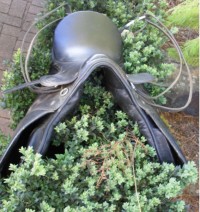
Presentation says a lot… Look at how the saddle’s presented. If it’s laid flat on the ground or is sat on a gate, the seller doesn’t know how to take care of it. And that attitude will go back a while.
- If you can see clouds reflected in its glossy surface, it may have been spray-lacquered or oiled up for the photo.
- If it needs a clean, then the seller couldn’t care less. Not now and not in the saddle’s time with them either.
- If it’s dirty, the leather may be dried out and cracked beneath the grime.
- You want to see at least 6 photos showing the saddle square-on from several directions.
- Look for overall symmetry. Many older saddles have twisted trees, caused by falls or by riders hauling on the cantle as they mount.
- Do you see any creases running across the seat? This can indicate a cracked or broken tree. If the stitching has come loose, then that’s even more likely. (It’s next to impossible to spot a broken tree in a western saddle from a photo.)
-
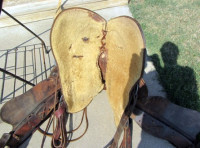
Avoid worn fleece Make sure you see a photo of the saddle’s underside. Check for visible bumps in the panels, which show it needs reflocking (more expense).
- With a felt or fleece skirt, you need to look for areas of heavy wear that may indicate problems.
- Leather girth billets need to be sound and uncracked. In a Western saddle, how does the rigging look?
- Can you see any rust on the fittings? Metal should be brass or stainless steel. If it rusts, it’s cheap iron and may break in use. Rust also damages leather.
Step 5. Find out what size it really is (not what the seller says it is)
Next, get stuck into the description. Saddles are usually marked or stamped with the size, although this may have rubbed away. If so, sellers will often make an uninformed decision about the size. That’s usually called a guess.
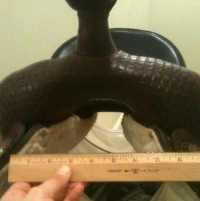
Here’s how their minds work. They reckon their horse is narrow, so the saddle must be too. Their horse once had a medium fit saddle, so this one must be a medium too. Then they measure across the gullet, at some point that seems about right. This gives them a gullet measurement (of sorts). Being helpful, they then add this to the description too. They may even include a photo.
And it goes further: many sellers can’t measure the saddle’s seat size, not for love nor money. And they write some other things that are pretty, well, misguided. They’ll tell you the saddle fits horses of a certain height. Or, that will fit most horses. Or, indeed, that it will fit any or even all horses.
Ignore this stuff. It’s rubbish. At best they’ve got it wrong – at worst, they’ve a paddock full of ruined horses.
You should be getting the message that distrusting anything a seller says that sounds like an opinion is a sensible way to go. This is why it’s so important to know exactly what size you’re looking for before you start. Then you can use the measurements from your tested saddle and ask the seller to measure theirs in exactly the same spots. (You can only compare the same makes and models, remember – nothing is standard in saddle making.)
If they can’t be bothered to help, don’t you bother either. Just walk.
Step 6. Play detective – can you trust this seller?
There’s a sliding scale of integrity when it comes to sellers. At one end of the scale are sellers who are as-honest-as-the-day-is-long. At the other end, you have the ruthless scammer.
Alongside this there’s another scale: saddle knowledge. Some sellers are very informed, while others are totally clueless.
This is where it gets a bit murky. Many are a mixture of each and it’s up to you to work out the combined knowledge and honesty levels of the person you’re talking saddles with. It’s not as hard as it sounds. Are these three types of seller familiar to you?
-
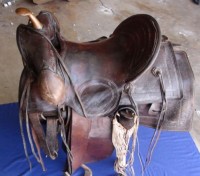
Flogging gear from an estate sale… The easiest ones to spot are dishonest and know nothing about horses or saddles. They’re often to be found selling old saddles that came from an estate sale. Sometimes you’ll get the sense that they may even be stolen. How do you spot them? They use phrases like ‘’horse riding saddles’’, ‘’straps’’ (girths) and even ‘’foot rests” (stirrups).
- Harder to spot are sellers who are into horses but are so desperate to sell that they’ll bend the truth to push up the price. These people will often exaggerate wildly and use really over-the-top language to describe the saddle. They’re trying to convince you the saddle is the best, absolutely the best, that you’ll see for sale anywhere online and that this is an unmissable opportunity.
- Then there are the more benign sellers, who don’t mean to rip anyone one off, but are unfortunately hopeless at organizing anything and will really mess up your transaction. These people make a mess of the listing, are dreadful at answering questions and will probably call you by the wrong name (and sometimes themselves).
If something doesn’t seem right, walk away. Never persuade yourself, no matter how good the saddle looks.
There are other ways to protect your interests. If you’re looking on eBay, always check a seller’s feedback, both as a seller and a buyer. Check what items they’ve bought in the past few months. Do their ebay purchases include the saddle you’re looking at? If so, they are either habitual resellers, or are trying to sell on a mistake they made.
Do look into their feedback percentages. If a power seller has upset 1% of their customers, that can be a huge number. Always check out the negative comments.
Forums feel safer, but if you’re buying there, remember that people are not always as they seem. If you’ve known them a long time, you’re on safer ground, but do still check all the details. Sometimes, a mutual friend or online acquaintance may know them. If nobody seems to know them, be careful.
Step 7. Beware the words of unseen saddlers
Some people will say anything to make a sale. At first glance, the words seem reassuring, especially if they include the word ‘saddler’. But you should be more than cautious if the sentence goes something like this:
“A saddler told me this wouldn’t be a problem to repair”.
Point one. If no saddler is named, then this viewpoint could be anyone’s. Absolutely anyone’s. You don’t know who the saddler is, how well qualified they are or what their reputation is. They may have learned how to make saddles in World War II and haven’t updated their skills since. They may have learned from some old man on a ranch in the middle of nowhere who once took a saddle he inherited from his grandfather apart and thought, “Hey I could make one of those” and went on to do just that.
Or, they may not even exist. Some people in areas where there are no saddlers (remote areas of large continents, for instance) take their saddles to leather workers who are normally busy making handbags and belts. And naturally, they take their advice.
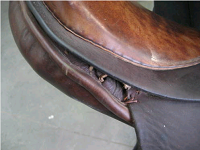 Point two. If a repair is needed, why hasn’t the seller hasn’t already had it done? There may be a good reason (they changed their horse). The bad reason may be that it’s too expensive compared with the saddle’s value. Repairing a broken tree can cost a bomb, as it’s close to a total rebuild.
Point two. If a repair is needed, why hasn’t the seller hasn’t already had it done? There may be a good reason (they changed their horse). The bad reason may be that it’s too expensive compared with the saddle’s value. Repairing a broken tree can cost a bomb, as it’s close to a total rebuild.
If you can get details of who exactly said what and the figures involved, all well and good. If not, get quotes from your own trusted, reputable saddler.
However, it’s safest to walk away. Repairs are unknown factors that increase your risk.
Step 8. Ask questions – many, many questions
Sellers will often write just a few lines or will copy the sales blurb from a website. Neither tells you much, so you have to ask your own questions. Start with the following list and add your own.
When you’re looking at higher priced saddles, sellers are often more receptive to questions. They gave that purchase a lot of thought so are more likely to understand why you are.
- What is the saddle’s history? How long have you owned it? Where did you buy it?
- What have you used the saddle for? And how much use has it had – daily, weekly, monthly, show days only?
- How and where has it been kept? Has it been covered up? Has it been stored in a dry room or outdoors in a damp barn or shed?
- Are there any marks on the leather that don’t show in the photographs?
- What condition are the fenders and cinch straps or stirrup leathers and girth billets in?
- How is the stitching? Is any frayed or coming away? Ask for a close-up photo of any faults.
- Has it been reflocked? Has the fleece been replaced?
- What is included with the sale? (Sellers usually say if girth, cinch, stirrup leathers or fenders come with it, but if they don’t, double-check.)
- Does it have a serial number? (This is a great question when you’re buying a newer branded saddle, as you can usually email the manufacturer and find out exactly how old it is, what style and size it is, and what features it should have.)
Remember: every unanswered question increases your risk. Answered questions reduce risk, providing you know what to ask.
Step 9. Put your safety net in place
Now you’re at the point of buying. You know a lot about the saddle and feel confident in the person selling it. But you’re not home and dry yet. Just in case things aren’t quite right, you need to check where the exits are.
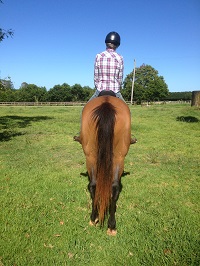
Ask the seller for a trial period of a week or five days.
That’s right, check whether you can return the saddle for a full refund. Yes, really. Even if it’s a purchase from ebay. You’re free to negotiate and can write up an agreement between you both.
Many sellers will agree, providing you cover the shipping costs both ways and pay the fees for re-listing it. True, you’ll lose some money, but it’s small beer next to the cost of a saddle that isn’t right. Some won’t want to do a trial period, but you can’t afford not to.
You can also protect your interests by making the sale traceable. Insist on an insured shipping service where a signature is required on delivery. Use this if you return the saddle too. Ensure you receive both an invoice and receipt.
Also use traceable payment methods, that come with cover from the payment service. Never just deposit money directly into someone’s account. Paypal will cover you for purchases made on eBay, meaning you can get your money back if a seller goes bad on you. (It can take a while, but it’ll come.) If you’re buying from an online merchandiser, use a credit card, as you’ll be given cover too. Wiring money by other services can be problematic, as your credit card won’t have been directly linked to the purchase.
Step 10. Take the saddle for a test drive
When your saddle arrives, get it checked by a reputable saddler, unless you know exactly how to check a saddle’s condition. There’s no substitute for an experienced eye, so don’t skip this step.
Even saddles of the same make and model can vary. Sometimes it’s because it was made by hand. Sometimes it’s in what’s happened since – materials can distort and maintenance such as reflocking give variable results. If the saddler identifies a problem, you can either return the saddle at the end of the trial period, request a reduction in the price, or decide how to resell it.
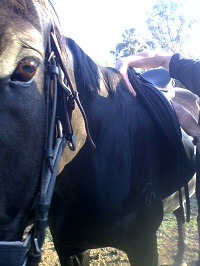
Always arrange for the saddler to check the saddle on your horse, unless you know how to check saddle fit for yourself. Use the trial period to check and double-check every aspect of the saddle’s fit. You can always recoup your money from the purchase, but damage to your horse’s back is another matter.
And, of course, have a good ride in it. It may be superb in every way, but your horse may not share that view. Do pay attention to your horse’s way of moving and reactions. If these don’t feel right or normal, then listen to your horse.
Hopefully, all your time spent researching will pay off and all will be well. This is where the excitement starts. At last, you can relax and being an exciting new phase in your riding partnership with your horse.
Welcome to The Horse’s Back!
I hope you’ve enjoyed this article and find it useful. Please feel free to share it with others who may be interested. I’m also interested in your comments, which you can write below.
If you’d like to read more, The Horse’s Back is a thoughtful site for articles, discussion and articles on equine saddle fit and bodywork.
